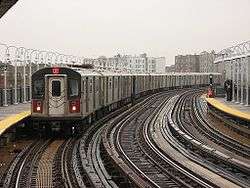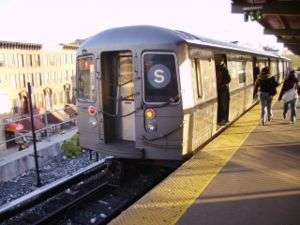ME-1 (New York City Subway car)
| ME-1 | |
|---|---|
|
SIRT ME-1 Car 388 on display at the Shore Line Trolley Museum in 2010. | |
| Manufacturer | Standard Steel Car Company |
| Replaced | 1973 |
| Constructed | 1925-1926 |
| Number built | 100 (90 Motors, 10 Trailers) |
| Number preserved | 2 |
| Number scrapped | 98 |
| Fleet numbers |
300-389 (motors) 500-509 (trailers) Note: Trailers 502, 505-507, and 509 converted to motor cars 390-394 in 1928 |
| Capacity | 240: 71 (seated) 169 (standing) |
| Operator(s) |
Staten Island Railway New York City Transit Authority |
| Specifications | |
| Car body construction | Steel |
| Car length | 67 ft 3 in (20.50 m) |
| Width | 10 ft 0 in (3,048 mm) |
| Height | 12 ft 1.125 in (3,686 mm) |
| Floor height | 3 ft 9.125 in (1.15 m) |
| Doors | 6 |
| Maximum speed | 60 mph (97 km/h) |
| Weight |
Motor car: 95,750 lb (43,430 kg) Trailer car:None |
| Traction system |
Motor car: GE PC 10L using GE 282A motors (200hp each). 2 motors per car (1 per truck). Trailer car: None |
| Power output | 200 hp (149 kW) per traction motor |
| Electric system(s) | 600 V DC Third rail |
| Current collection method | Top running Contact shoe |
| Braking system(s) | WABCO Schedule AMUE with UE-5 universal valve, ME-30 brake stand, and simplex clasp brake rigging |
| Coupling system | WABCO H2A |
| Track gauge | 4 ft 8 1⁄2 in (1,435 mm) |
The ME-1 was a rapid transit car built from 1925 to 1926 by the Standard Steel Car Company for the Staten Island Railway and later also used in the New York City Subway. They were the first electric cars to run in revenue service on the SIRT.[1] They are also frequently referred to as MU-1s or MUE-1s. The 25 cars purchased by the New York City Transit Authority to run in the subway were nicknamed B-29s, a reference to a large aircraft of the same name. This nickname was derived from the cars' large size (67 feet or 20.42 meters) and the fact that the cars had been renumbered for subway service into the 2900's.
Service history
A total of 100 cars were purchased from the Standard Steel Car Company[2] - 90 motors and 10 trailers. The 90 motors were built in 1925, and the 10 trailers in 1926.
Purchased by the Staten Island Rapid Transit's former operator, the Baltimore and Ohio Railroad, the cars were built to replace steam-powered equipment on the railroad, and in preparation for the Staten Island Tunnel connection to the BMT Fourth Avenue Line in Brooklyn. Because of this, the cars were built to Brooklyn–Manhattan Transit Corporation (BMT) subway specifications, and strongly resembled the BMT's AB Standard.[2][3][4] The cars debuted in 1925, shortly after the electrification of the railroad.[2][3] They ran continuously on the three SIRT lines (North Shore Line, South Shore Line, South Beach Branch) until 1953, when the South Beach Branch and North Shore Line closed. In 1953-54, 25 of these cars were purchased from the SIRT by the New York City Transit Authority to run over former BMT lines and did so until 1961.[2] The remaining 48 cars (many had been lost in several fires)[2] soldiered on the remaining SIRT main line (the South Shore or Tottenville Line; now the Main Line) until their last revenue service in 1973. Due to the shortage of equipment, all but four cars would be used in peak operation.[2][5]
Following their 1973 retirement from service on Staten Island, they were replaced by the original 52 R44 SI fleet of cars. A total of 63 R44s (some transfers from the subway system) are currently in use as of 2015.[2][6]
Preservation
- Car 388 was purchased by the Shore Line Trolley Museum in East Haven, Connecticut and is undergoing restoration.[7]
- Car 366 was purchased by the Seashore Trolley Museum and is also undergoing restoration.
- Car 353 had survived on a track in the Travis Yards[8] and was acquired by the Trolley Museum of New York based in Kingston, New York.[9] However, the car was scrapped sometime around 2004 or 2005 before transportation was able to be arranged to Kingston.
In recent years, a railroad historian from Staten Island named Peter Giunta has been searching for vintage SIRT equipment for a possible museum display on Staten Island. He hopes to locate either an ME-1 or one of its earlier non-electrified counterparts.[10]
ME-1 Specifications
- Car Length: 67 feet (20 m) over the car's end buffers; 67 feet 3.5 inches (20.511 m) over pulling face of couplers. 47 feet (14 m) between truck centers. The truck wheelbase is 81 inches (2.1 m).[11]
- Car Width: 9 feet 9 3⁄16 inches (2.977 m) over the side plates. 9 feet 10.5 inches (3.010 m) over eaves and side door tread plates. Clerestory width of monitor roof is 6 feet 3.125 inches (1.90818 m) over edges.[11]
- Car Height: 3 feet 1.5 inches (0.95 m) top of tail to bottom edge of side sills; 3 feet 10.5 inches (1.18 m) top of rail to of car side door tread plates (platform height); 7 feet 2.5 inches (2.20 m) bottom edge of side sills to eaves; 9 feet 10 3⁄16 inches (3.00 m) top of rail to top of car line (roof); 12 feet 1 11⁄16 inches (3.70 m) top of tail to top of car line (roof).[11]
- Car Weight: light weight of body, complete: 55,650 pounds (25,240 kg); light weight of trucks complete with motors: 40,100 pounds (18,200 kg); total weight: 95,750 pounds (43,430 kg)[11]
See also
- AB Standard, a similar car built for the New York City Subway by both the Pressed Steel Car Company and by the American Car and Foundry Company.
References
- ↑ Ponder New Law. The New York Times, June 5, 1923.
- 1 2 3 4 5 6 7 Leigh, Irvin; Matus, Paul (January 2002). "Staten Island Rapid Transit: The Essential History". thethirdrail.net. The Third Rail Online. Retrieved 27 June 2015.
- 1 2 Pitanza, Marc (2015). Staten Island Rapid Transit Images of Rail. Arcadia Pubishing. ISBN 978-1-4671-2338-9.
- ↑ "Staten Island Is Not a Commuting Community". Brooklyn Daily Eagle. October 5, 1924. p. 67. Retrieved 26 April 2016 – via Newspapers.com.
- ↑ "Staten Island Railway". stationreporter.net.
- ↑ "MTA Capital Program 2015-2019: Renew. Enhance. Expand." (PDF). Metropolitan Transportation Authority. October 28, 2015. Retrieved 28 October 2015.
- ↑ "About car 388". bera.org.
- ↑ "Abandoned 1925 vintage Staten Island Rapid Transit car 353 – 2003. - ltvsquad.com". ltvsquad.com.
- ↑ "Showing Image 31284". nycsubway.org.
- ↑ "Tracking down a train to preserve the past". SILive.com.
- 1 2 3 4 The Baltimore & Ohio Railroad Co. Diagrams of Passenger Equipment Updated to 1958, TLC Publishing, Inc. Lynchburg VA 24503 Page: SIRT Electric Motor Cars, Class ME-1.
External links
- http://www.nycsubway.org/cars/bmtodd.html
- https://www.flickr.com/photos/127872292@N06/22111012251/in/dateposted/




